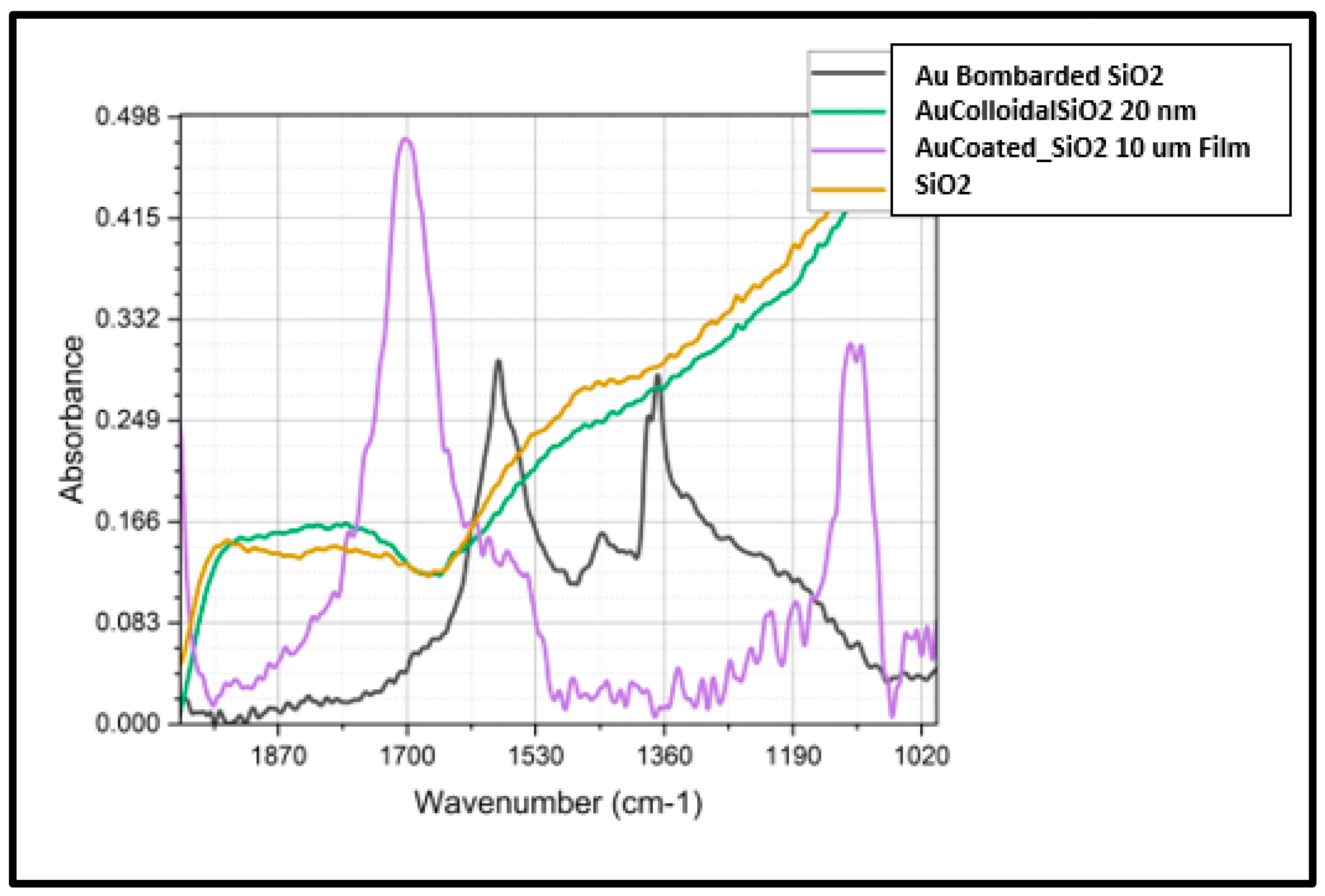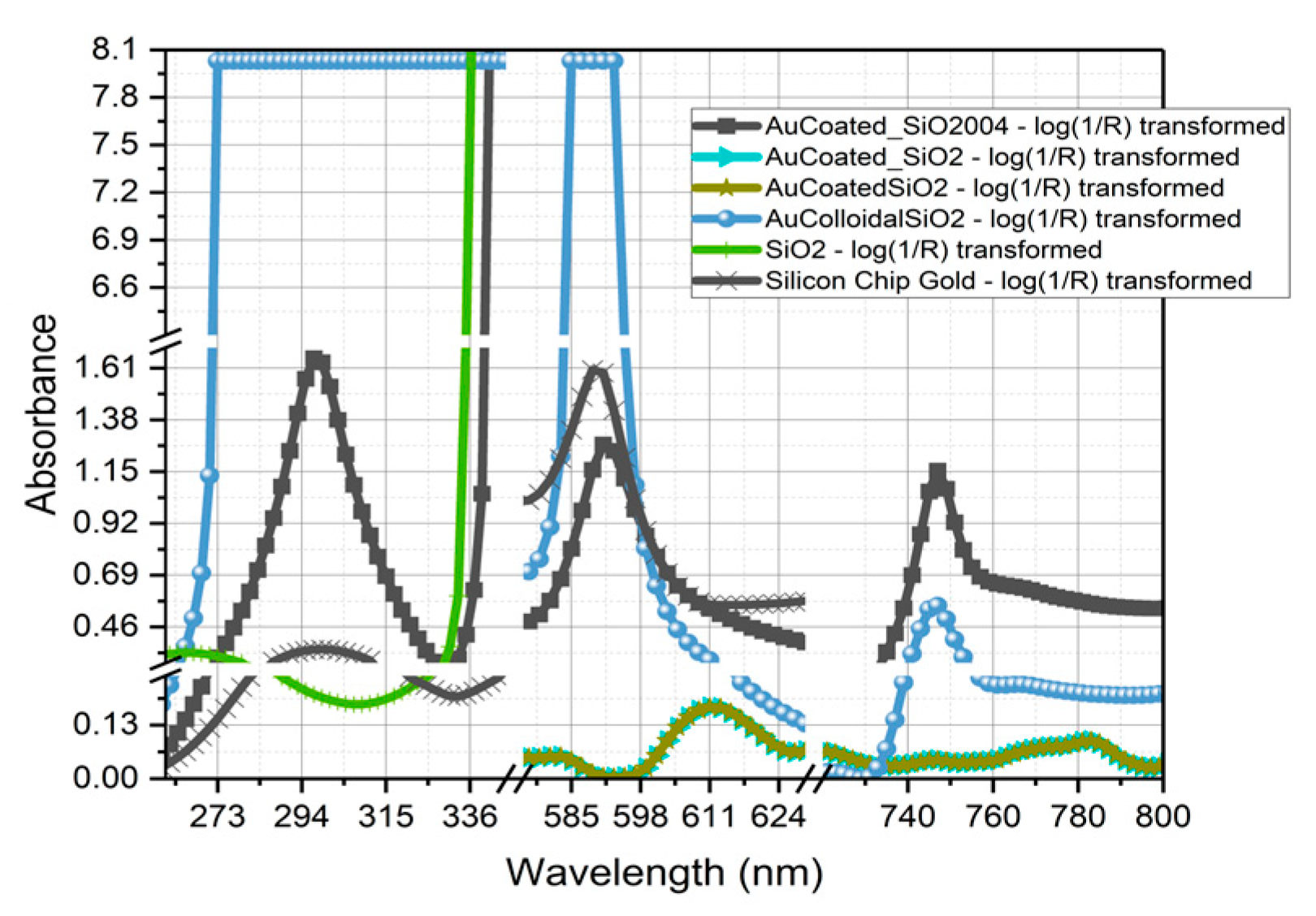Fano Resonance in Ion-Bombarded Au-SiO2 Nanocomposites: Analysis of Mode Coupling and Optical Properties
Abstract
1. Introduction
2. Methods
2.1. Sample Preparation
2.2. Absorbance Measurements
- A() is the absorbance at wavenumber;
- I0() is the intensity of the background;
- I() is the intensity of the sample spectrum.
2.3. UV-Vis Measurements
3. Results and Discussion
3.1. Elevated Baseline and Enhanced Fano Resonance in Ion-Bombarded Au Samples
3.2. Comparison with Other Samples
3.3. UV-Vis Spectra Analysis
3.4. Mechanistic Insights and Theoretical Modeling
3.5. Implications for Nanophotonic Applications
4. Conclusions
Author Contributions
Funding
Institutional Review Board Statement
Informed Consent Statement
Data Availability Statement
Conflicts of Interest
References
- Limonov, M.F.; Rybin, M.V.; Poddubny, A.N.; Kivshar, Y.S. Fano Resonances in Photonics. Nat. Photonics 2017, 11, 543–554. [Google Scholar] [CrossRef]
- Miroshnichenko, A.E.; Flach, S.; Kivshar, Y.S. Fano Resonances in Nanoscale Structures. Rev. Mod. Phys. 2010, 82, 2257–2298. [Google Scholar] [CrossRef]
- Luk’yanchuk, B.; Zheludev, N.I.; Maier, S.A.; Halas, N.J.; Nordlander, P.; Giessen, H.; Chong, C.T. The Fano Resonance in Plasmonic Nanostructures and Metamaterials. Nat. Mater. 2010, 6, 707–715. [Google Scholar] [CrossRef]
- Willets, K.A.; Van Duyne, R.P. Localized Surface Plasmon Resonance Spectroscopy and Sensing. Annu. Rev. Phys. Chem. 2007, 58, 267–297. [Google Scholar] [CrossRef]
- Kelly, K.L.; Coronado, E.; Zhao, L.L.; Schatz, G.C. The Optical Properties of Metal Nanoparticles: The Influence of Size, Shape, and Dielectric Environment. J. Phys. Chem. B 2003, 107, 668–677. [Google Scholar] [CrossRef]
- Cottancin, E.; Celep, G.; Lerme, J.; Pellarin, M.; Huntzinger, J.-R.; Vialle, J.-L.; Broyer, M. Optical Properties of Noble Metal Clusters as a Function of the Size: Comparison between Experiments and a Semi-Quantal Theory. Theor. Chem. Acc. 2006, 116, 514–523. [Google Scholar] [CrossRef]
- Schmidt, M.K.; Esteban, R.; Gonzalez-Tudela, A.; Giedke, G.; Aizpurua, J. Quantum Mechanical Description of Raman Scattering from Molecules in Plasmonic Cavities. ACS Nano 2016, 10, 6291–6298. [Google Scholar] [CrossRef]
- Xiao, Y.; Du, J. Superparamagnetic Nanoparticles for Biomedical Applications. J. Mater. Chem. B 2020, 8, 354–367. [Google Scholar] [CrossRef]
- Wang, X.; Liu, G.; Xia, S.; Meng, H.; Shang, X.; He, P.; Zhai, X. Dynamically Tunable Fano Resonance Based on Graphene Metamaterials. IEEE Photonics Technol. Lett. 2018, 30, 2147–2150. [Google Scholar] [CrossRef]
- Güner, S.; Budak, S.; Amaral, R.; Minamisawa, C.; Muntele, C.; Ila, D. Thickness and MeV Si Ions Bombardment Effects on the Thermoelectric Properties of Ce3Sb10 Thin Films. Nucl. Instrum. Methods Phys. Res. Sect. B Beam Interact. Mater. At. 2008, 266, 1261–1264. [Google Scholar] [CrossRef]
- Hentschel, M.; Saliba, M.; Vogelgesang, R.; Giessen, H.; Alivisatos, A.P.; Liu, N. Fano Resonances in Plasmonic Nanoparticle Aggregates. J. Phys. Chem. C 2009, 113, 5540–5544. [Google Scholar] [CrossRef]
- Huck, C.; Vogt, J.; Sendner, M.; Hengstler, D.; Neubrech, F.; Pucci, A. Plasmonic Enhancement of Infrared Vibrational Signals: Nanoslits versus Nanorods. ACS Photonics 2015, 2, 1489–1497. [Google Scholar] [CrossRef]
- Hao, F.; Nehl, C.L.; Hafner, J.H.; Nordlander, P. Symmetry Breaking in the Hydrogenation of Gold Clusters. Nano Lett. 2004, 4, 327–330. [Google Scholar] [CrossRef]
- SPIE. Coupling Effects in Plasmonic Nanostructures and Metamaterials. Available online: https://spie.org/news/4948-coupling-effects-in-plasmonic-nanostructures-and-metamaterials (accessed on 17 May 2025).
- Kauranen, M.; Zayats, A.V. Nonlinear Plasmonics. Nat. Photonics 2012, 6, 737–748. [Google Scholar] [CrossRef]
- Steele, J.M.; Grady, N.K.; Nordlander, P.; Halas, N.J. Plasmon Hybridization in Complex Nanostructures. In Surface Plasmon Nanophotonics; Maier, S.A., Atwater, H.A., Eds.; Springer Series in Optical Sciences; Springer: Dordrecht, The Netherlands, 2007; Volume 131, pp. 183–196. [Google Scholar] [CrossRef]
- Bhat, S.A.; Rao, S.; Prasad, S.K.; Yelamaggad, C. Tuning the Optical Properties of Gold Nanoparticles via Photoactive Liquid Crystalline Azo Ligands. Nanoscale 2025, 17, 3123–3132. [Google Scholar] [CrossRef] [PubMed]
- Jain, P.K.; Lee, K.S.; El-Sayed, I.H.; El-Sayed, M.A. Calculated absorption and scattering properties of gold nanoparticles of different size, shape, and composition: Applications in biological imaging and biomedicine. J. Phys. Chem. B 2006, 110, 7238–7248. [Google Scholar] [CrossRef] [PubMed]
- Link, S.; El-Sayed, M.A. Optical properties and ultrafast dynamics of metallic nanocrystals. Annu. Rev. Phys. Chem. 2003, 54, 331–366. [Google Scholar] [CrossRef]
- Grimmer, M.; Tao, W.; Fleischer, M. Enhancing Fano Resonances through Coupling of Dark Modes in a Dual-Ring Nanostructure. Opt. Express 2024, 32, 1926–1940. [Google Scholar] [CrossRef]
- Lu, H.; Li, D.; Shi, S.; Li, Y.; Zhao, J. Exciton-Induced Fano Resonance in Metallic Nanocavity with Tungsten Disulfide Atomic Layer. Opt. Express 2023, 31, 20761–20768. [Google Scholar] [CrossRef]
- Ma, C.; Yan, J.; Huang, Y.; Yang, G. Directional Fano Resonance in an Individual GaAs Nanospheroid. Small 2019, 15, 1900546. [Google Scholar] [CrossRef]
- Gong, T.; Guan, F.; Wei, Z.; Huang, W.; Zhang, X. Tunable Magnetic Fano Resonances on Au Nanosphere Dimer–Dielectric–Gold Film Sandwiched Structure. Front. Phys. 2021, 9, 691027. [Google Scholar] [CrossRef]
- Grineviciute, L.; Nikitina, J.; Babayigit, C.; Staliūnas, K. Fano-like Resonances in Nanostructured Thin Films for Spatial Filtering. Appl. Phys. Lett. 2021, 118, 131114. [Google Scholar] [CrossRef]
- Petrosyan, P. Influence of Interaction Retardation and Radiation Reaction on the Fano Resonance Efficiency in the System of Nanoparticles. J. Contemp. Phys. 2018, 53, 324–331. [Google Scholar] [CrossRef]
- Ren, J.; Qiu, W. Generating and Tuning the Fano Resonance by Graphene Oligomers with Different Nanostructures. Proc. SPIE 2018, 10964, 109645I. [Google Scholar] [CrossRef]
- Chen, J.; Gan, F.; Wang, Y.; Li, G. Plasmonic Sensing and Modulation Based on Fano Resonances. Adv. Opt. Mater. 2018, 6, 1701152. [Google Scholar] [CrossRef]
- Zheng, C.; Jia, T.; Zhao, H.; Xia, Y.; Zhang, S.; Feng, D.; Sun, Z. Theoretical Study on Narrow Fano Resonance of Nanocrescent for the Label-Free Detection of Single Molecules and Single Nanoparticles. RSC Adv. 2018, 8, 3381–3391. [Google Scholar] [CrossRef]
- Shiryaev, A.; Ekimov, E.; Prokof’ev, V.; Kondrin, M. Temperature Dependence of the Fano Resonance in Nanodiamonds Synthesized at High Static Pressures. JETP Lett. 2022, 115, 651–656. [Google Scholar] [CrossRef]
- Kim, K.-H.; Ri, M. Metal–Dielectric Composite Nanostructures for Fano Resonance-Based Highly Sensitive SECARS from Visible to Deep-UV. J. Phys. Chem. C 2018, 122, 16281–16288. [Google Scholar] [CrossRef]


Disclaimer/Publisher’s Note: The statements, opinions and data contained in all publications are solely those of the individual author(s) and contributor(s) and not of MDPI and/or the editor(s). MDPI and/or the editor(s) disclaim responsibility for any injury to people or property resulting from any ideas, methods, instructions or products referred to in the content. |
© 2025 by the authors. Licensee MDPI, Basel, Switzerland. This article is an open access article distributed under the terms and conditions of the Creative Commons Attribution (CC BY) license (https://creativecommons.org/licenses/by/4.0/).
Share and Cite
Guggilla, P.; Palwai, S.; Davis, A.; Lassiter, J.; Budak, S.; Varner, C. Fano Resonance in Ion-Bombarded Au-SiO2 Nanocomposites: Analysis of Mode Coupling and Optical Properties. Coatings 2025, 15, 605. https://doi.org/10.3390/coatings15050605
Guggilla P, Palwai S, Davis A, Lassiter J, Budak S, Varner C. Fano Resonance in Ion-Bombarded Au-SiO2 Nanocomposites: Analysis of Mode Coupling and Optical Properties. Coatings. 2025; 15(5):605. https://doi.org/10.3390/coatings15050605
Chicago/Turabian StyleGuggilla, Padmaja, Sharvare Palwai, Angela Davis, Jonathan Lassiter, Satilmis Budak, and Clyde Varner. 2025. "Fano Resonance in Ion-Bombarded Au-SiO2 Nanocomposites: Analysis of Mode Coupling and Optical Properties" Coatings 15, no. 5: 605. https://doi.org/10.3390/coatings15050605
APA StyleGuggilla, P., Palwai, S., Davis, A., Lassiter, J., Budak, S., & Varner, C. (2025). Fano Resonance in Ion-Bombarded Au-SiO2 Nanocomposites: Analysis of Mode Coupling and Optical Properties. Coatings, 15(5), 605. https://doi.org/10.3390/coatings15050605






